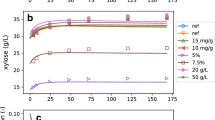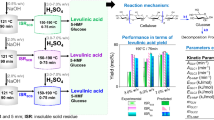Abstract
The enzyme cellobiase Novozym 188, which is used for improving hydrolysis of bagasse with cellulase, was characterized in its commercial available form and integrated kinetic models were applied to the hydrolysis of cellobiose. The specific activity of this enzyme was determined for pH values from 3.0–7.0, and temperatures from 40–75°C, with cellobiose at 2 g/L. Thermal stability was measured at pH 4.8 and temperatures from 40–70°C. Substrate inhibition was studied at the same pH, 50°C, and cellobiose concentrations from 0.4–20 g/L. Product inhibition was determined at 50°C, pH 4.8, cellobiose concentrations of 2 and 20 g/L, and initial glucose concentration nearly zero or 1.8 g/L. The enzyme has shown the greatest specific activity, 17.8 U/mg, at pH 4.5 and 65°C. Thermal activation of the enzyme followed Arrhenius equation with the Energy of Activation being equal to 11 kcal/mol for pH values 4 and 5. Thermal deactivation was adequately modeled by the exponential decay model with Energy of Deactivation giving 81.6 kcal/mol. Kinetics parameters for substrate uncompetitive inhibition were: Km=2.42 mM, V max=16.31 U/mg, Ks=54.2 mM. Substrate inhibition was clearly observed above 10 mM cellobiose. Product inhibition at the concentration studied has usually doubled the time necessary to reach the same conversion at the lower temperature tested.
Similar content being viewed by others
References
Cantarella, M., Gallifuoco, A., Scardi, V., and Alfani, F. (1984), Ann. NY Acad. Sci. 434, 39–43.
Woodward, J. (1991), Biores. Technol. 36, 67–75.
Aguado, J., Romero, M. D., Rodríguez, L., and Calles J. A. (1995), Biotechnol. Prog. 11, 104–106.
Hsuanyu, Y. and Laidler, K. J. (1984), Can. J. Biochem. Cell. Biol. 63, 167–175.
Gong, C.-S., Ladisch, M. R., and Tsao, G. T. (1977), Biotechnol. Bioeng. 19, 959–981.
Woodward, J. and Capps, K. M. (1992). Appl. Biochem. Biotechnol. 34/35, 341–347.
Dixon, M. and Webb, E. C. (1979), Enzymes, 3rd ed., Longman Group Limited, London, pp. 7–15, 127.
Trinder, P. (1969), Ann. Clin. Biochem. 6, 24–27.
Lowry, O. H., Rosebrough, N. J., Farr, A. L., and Randall, R. J. (1951), J. Biol. Chem. 193, 265–275.
Morita, T. and Assumpção, R. M. V. (1972), Manual de Soluções reagentes e solventes— padronização—preparação—purificação, 2nd ed. Edgard Blücher Ltda, São Paulo, pp. 272–275.
Chaplin, M. F. and Bucke, C. (1992), Enzyme Technology, Cambridge University Press, Cambridge, pp. 18–23.
Segel, I. H. (1975), Enzyme Kinetics, Wiley, New York, pp. 18–24.
Haldane, J. B. S. (1930), Enzymes, Longman, Green and Co., London, p. 83.
Woodward, J., Koran, L. J., Jr., Hernandez, L. J., and Stephan, L. M. (1993), ACS Symposium Series 533, 240–250.
Dekker, R. F. H. (1986), Biotechnol. Bioeng. 28, 1438–1442.
Beltrame, P. L., Carniti, P., Focher, B., Marzetti, A., and Sarto, V. (1983), La Chimica e L'Industria 65(6), 398–401.
Alfani, F., Cantarella, L., Gallifuoco, A., Pezzullo, L., Scardi, V., and Cantarella, M. (1987), Ann. NY Acad. Sci. 503–507.
Maguire, R. J. (1977), Can. J. Biochem. 55, 19–26.
Bisset, F. and Sternberg, D. (1978), Appl. Environ. Microbiol. 35(4), 750–755.
Sundstrom, D. W., Klei, H. E., Coughlin, R. W., Biederman, G. J., and Brouwer, C. A. (1981), Biotechnol. Bioeng. 23, 473–485.
Zanin, G. M. and Moraes, F. F. de. (1998), Appl. Biochem. Biotechnol. 70/72, pp. 383–394.
Bassetti, F. J., Bergamasco, R., Moraes, F. F. de., and Zanin, G. M. (1997). in Trabajos Present adosler Congresso de Ingenieria de Procesos del Mercosur, Bahia Blanca-Argentina, pp. 233–234.
Zanin, G. M. and Moraes, F. F. de. (1996), Appl. Biochem. Biotechnol. 57/58, 617–625.
Grous, W., Converse, A., Grethlein, H., and Lynd, L. (1985), Biotechnol. Bioeng. 27, 463–470.
Author information
Authors and Affiliations
Corresponding author
Rights and permissions
About this article
Cite this article
Calsavara, L.P.V., De Moraes, F.F. & Zanin, G.M. Modeling cellobiose hydrolysis with integrated kinetic models. Appl Biochem Biotechnol 79, 789–806 (1999). https://doi.org/10.1385/ABAB:79:1-3:789
Issue Date:
DOI: https://doi.org/10.1385/ABAB:79:1-3:789




